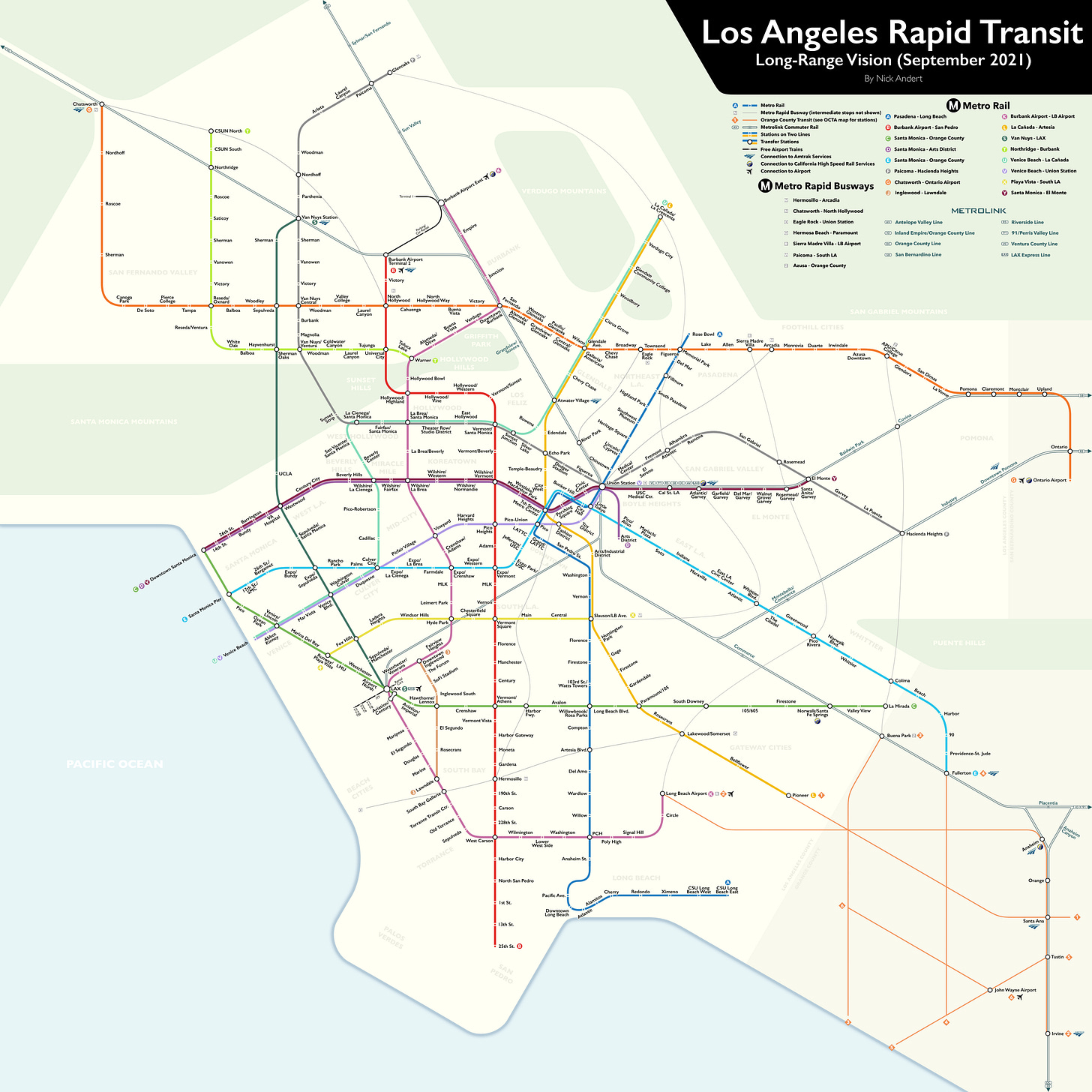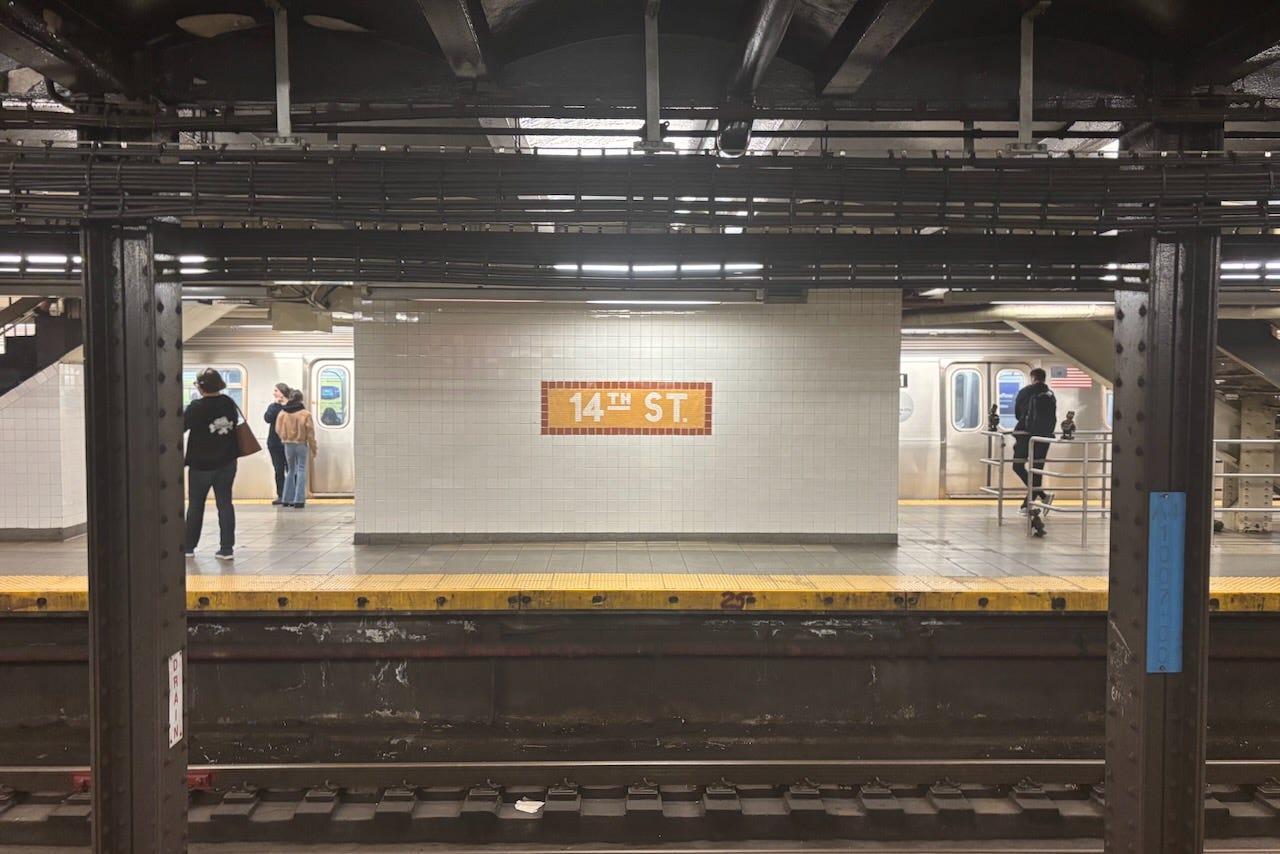Transit and techno-futurism
When new tech arrives, what other futures does America lose in its embrace?
NYC transit is only so-so. Sure, it’s fabulous by American standards, but what a low bar that is. Among the features New York’s system lacks that are now commonplace elsewhere: through-running regional trains, platform screen doors, air-conditioned stations, express airport connections, and integration with true high-speed rail, not to mention the three basics of good transit: reliability, frequency, and comprehensiveness. So, as Americans are prone to grumble online, why can’t we have nice things?
Living in New York for a few months inspired me to re-read Jake Berman’s The Lost Subways of North America, a beautiful collection of maps and essays that details the transit systems that once existed in more than twenty North American cities. The book reveals how America’s underwhelming transit today is the result of decisions made in the middle of the last century. The story is well-known, but remains one of the great self-inflicted tragedies of American history:
In the decades after World War II, the United States spent immense amounts of money bulldozing its cities to optimize them for the car. This happened because of a complex combination of circumstances […]: the United States’ tremendous postwar prosperity, subsidized suburban growth, the bad reputations of privately owned transit companies, the strength of the automobile lobby, racial strife, and the rush to rid cities of “blight” that characterized the spirit of the age. No matter what the specific pressures were in a city, the end result was usually the same. American cities shredded their cores so that suburbanites could drive downtown as quickly as possible.1
America chose to annihilate its cities to accommodate a new technological paradigm of its own invention. Imagine a different history, where just a tad more of the social surplus was consistently invested in transit over the past 75 years. New York could easily have built a system to rival Asian megacities. Rather than rip out their bones, cities across the country could have incrementally improved their rail systems: interurban railways would gradually become grade-separated, high-capacity lines through densified suburbs, interlining with subways built below old streetcar routes.
This incremental process is how modern-day Tokyo’s wondrous transit and housing abundance was built. Colin Marshall points out the deep similarity between Los Angeles and Tokyo that I also feel whenever I visit: both are microcosmic, multi-nodal, infinite sprawls. If LA had not dismantled the Pacific Electric Railway, which Berman notes was once the largest electric urban railway network in the world, Southland would have surely evolved to be more like Tokyo today in form, feeling, and density.2
City by city, Berman also outlines the many thwarted visions for new transit to replace what was torn out (New York took earlier stabs at its still-unfinished 2nd Avenue Subway in the 1920s, 1950s, and 1970s). Today, transit-futurist visions of America live on in the imaginations of transit advocates, whose beautifully designed maps are a natural accompaniment to Berman’s book. futureNYCSubway includes not just the 2nd Avenue Subway, but many other essential additions, such as an L train that turns up 10th Avenue to the Upper West Side and another line down 125th and onward to LaGuardia and Flushing in Queens, not to mention numerous outer borough extensions. Seattle Subway envisions a true transit metropolis, far beyond the city’s already ambitious rail construction plans. And if you’re interested in what a Tokyo-fied LA would look like, go no further than Nick Andert’s meticulous videos on YouTube. 3

The promise of endless space on a vast continent probably made some embrace of the car inevitable, and as suggested above, there were a myriad of reasons why things turned out as they did when urban America went to pieces. Nonetheless, more and better transit has always existed as one possible future in America. In most places and at most times, it has simply been a future we have chosen not to build.
While I wait for the subways to arrive, I refresh the Times to read about the latest assault on the institutions of American life. All those Biden-era plans to upgrade Amtrak and shift our cities towards sustainable transport have been cast aide with the Ancien Régime. But efforts to claw back rail funding and congestion pricing approval are merely the tip of the iceberg—the hollowing out of the civil service and the IRS’s ability to collect taxes is an attempt to salt the earth upon which future state capacity could be built. I can’t help but see parallels with the suicide of American cities a few generations before, with the ascendent tech reactionaries cast in the conspiratorial role of the oil, tire and car companies that bought up the streetcars and ripped out the rails.
The chief instigator of the American state’s suicide also happens to have monumentally bad ideas about transit. Musk has offered up two techno-futurist ideas for how we should get around, neither of which are real: the Hyperloop is in fact 200-year-old vaporware, while the Boring Company’s harebrained vision of cars in tubes is, to borrow Henry Grabar’s words, “a bona fide new idea that is so evidently a downgrade in transportation and mobility it’s no surprise no one thought of it before. A car! On a track! Underground!”4
Of course, Musk’s proposals are not made in good faith.5 The shiny object of unworkable sci-fi technology is designed to arouse his fanboys and gullible local TV news producers, thereby undermining public faith in the much slower process of implementing actual solutions by dangling the mirage of far better, cheaper, more fun technology just around the corner. This trolling increases the likelihood that America stumbles by default into his preferred future: one in which fleets of his own autonomous vehicles are the only viable option, and the state is shunted into the passive role of providing the pavement upon which he profits.
Such a vision of transportation is grotesquely inequitable and exclusionary, but in Musk’s case it seems to arise from something deeper than your run-of-the-mill oligarch’s hatred of providing nice things to the poor. He appears incapable of accommodating transit in his worldview because rails are an old technology, and incremental innovation is not worthy of the attention of a world-historical disruptor who deals in humanoid robots, spaceships, and AI.
Artificial intelligence is often compared to the automobile in descriptions of the far-reaching impacts of its adoption on our way of life and economy. In both cases, a zealous vanguard of the technological revolution justifies destructive behavior in the name of clearing the way for the future. They present a new tech paradigm as an unstoppable force of nature, where our choice is not among possible futures, but the speed of adaptation to inevitable change. Modern-day Muskites shrug at the evisceration of essential agencies out of a belief that most bureaucratic roles will soon be taken over by AI. Their smug confidence was probably shared by earlier vandals who looked up at the splendor of Penn Station, and thought, nah, won’t be needing this anymore.
Musk has company: some (not all) of the Silicon Valley technologists who have restyled themselves as urbanists believe the city is not worth building unless it can be a full-stack startup. Rather than muster political or venture capital to fix the Muni or connect high speed rail to the Bay, these visionaries are looking for the fastest exit to AI-run charter cities in the desert.6
Like the automobile, AI will come to all countries eventually, but I doubt many will preemptively torch their bureaucracies in anticipation of its arrival, just as few countries sacrificed their cities to the car as much as America did. Our transit deficit should be a reminder that when powerful people tell us to get onboard with a narrative of inevitable technological change, the appropriate question, to paraphrase Neil Postman, is not what the new technology does, but what it undoes—what other futures are foreclosed by accelerating towards one vision of progress.
In the not too distant future, a new generation of Americans may travel abroad to countries that have preserved the state capacity and social consensus to effectively provision public goods like physical infrastructure accessible to all, universal health care and education, and government services administered by competent and respected human beings. Like TikTok-ers taking their first ride on the Shinkansen, they will wonder aloud to their followers back home, why can’t we have nice things, too?
Berman, Chapter 23.
In such an LA, I would surely have spent my four years of college exploring rather than staying cloistered on campus in the Inland Empire.
If “Abundance Democrats” ever get ahold of the levers of power, transit expansion on such a scale would be key to unlocking cities beyond scarcity. Unfortunately, the sci-fi scenario of an abundant near future that opens Ezra Klein and Derek Thompson’s Abundance contains no mention of transit—only autonomous cars and drones, and a later chapter singles out California High Speed Rail as a poster child of dysfunction without offering much support for its rehabilitation. A focus on building more as fast as possible seems likely to lead down the path of least resistance with rapidly scalable technologies, but liberals will never reach the promised land of abundance if they abandon transit investments.
Well, Musk actually has three ideas for transport: he seems to believe his Starships—the largest rockets ever built—will be used for quick point-to-point hops between different parts of the planet, because business class jets are too onerous a mode of travel. He probably read The Man in the High Castle as a kid and loved it for all the wrong reasons.
Musk proposed his Hyperloop out of hatred for the California High Speed Rail. His Boring Company grift was hatched by tweet in traffic on the 405—and served to undermine the LA Metro’s actual push to bore a transformative tunnel beneath the same corridor.
The tech-utopians now seek to bolster their standing in the MAGA court with a recent proposal for a “freedom city” in Greenland.




that LA map looks amazing. though, it wouldve never matched tokyo for the fact that tokyo stretches out miles and miles further out of the city with trains that connect to the other prefectures. basically, you can hop on a train in tokyo and connect your way to the most southern point of japan, not the city, but the most southern or northern point in the country. GOAT train system period.